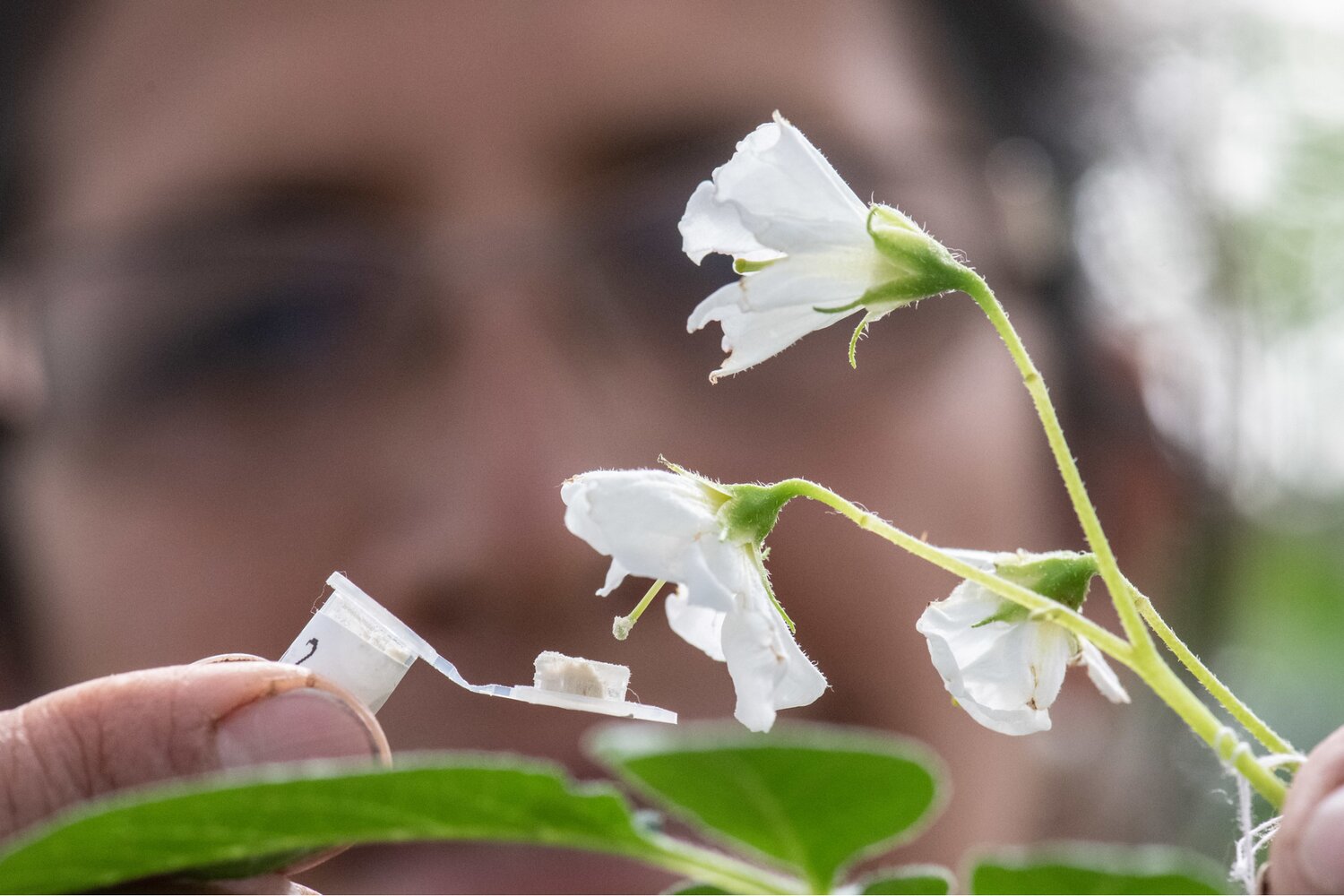Potato
Why potato?
The potato (Solanum tuberosum L.) is the most important tuber crop and the third-most important food crop globally, cultivated and consumed on six continents. The first potatoes were domesticated in South America between 8,000 to 10,000 years ago. The Central Andes region is home to more than 150 potato wild relatives, wild weedy cousins of the cultivated potatoes we eat today, most of which produce tubers that are too small and bitter to eat. However, these wild relatives have excellent tolerance to extremes, such as heat, drought and freezing temperatures. They also contain genes that help them resist pests and diseases, threats that are becoming worse under climate change.
What we achieved
Collecting
- 474 seed samples of 54 potato wild relative species were collected in six countries: Brazil, Chile, Costa Rica, Ecuador, Guatemala and Peru.
Pre-breeding and evaluation
- Fifteen potato wild relatives were used in pre-breeding efforts under this project: S. cajamarquense, S. chiquidenum, S. paucissectum, S. sogarandinum, S. tarijense, S. megistacrolobum S.microdontum., S. commersonii, S. boliviense, S. bukasovii, S. infudibuliforme, S. lignicaule, S. raphanifolium, S. tacnaense and S. tarapatanum.
- New breeding approach—diploid hybridization—developed and tested to facilitate pre-breeding between wild relatives and cultivated varieties.
- A new potato variety derived from a cross with a wild relative, CIP-Matilde, with almost complete resistance to late blight was released to farmers in Peru in October 2021.
- Farmers have been closely involved in selecting improved materials, helping ensure their uptake.
- Pre-bred lines developed from crosses with wild relatives shown to have good resistance to late blight and bacterial wilt—key diseases of potato—and tolerance of heat, drought and salinity.
- Promising lines based on crosses with wild relatives have been conserved in the genebank at the International Potato Center (CIP), Peru, for sharing with global users through SMTA.

Project partners
Collecting
- Embrapa Genetic Resources and Biotechnology, Brasilia, Brazil
- Instituto Nacional de Innovación Agraria, La Cruz, Chile
- Universidad de Costa Rica, San José, Costa Rica
- Instituto Nacional de Investigaciones Agropecuarias, Quito, Ecuador
- Instituto Nacional de Innovación Agraria, Lima, Peru
Pre-breeding and evaluation
Lead Institute: International Potato Center, Lima, Peru
Partners:
- Embrapa Genetic Resources and Biotechnology, Brasilia, Brazil
- Instituto Nacional de Investigación Agropecuaria, Montevideo, Uruguay
- YANAPAI Group, Concepción, Peru
Potato key collections, materials and data
Potato collections
- The largest potato collections are conserved at the Leibniz-Institut für Pflanzengenetik und Kultupflanzenforschung, Germany, the USDA-ARS genebanks, USA, and CIP, Peru.
- The Genesys PGR database also includes information about germplasm in genebanks worldwide, including the potato accessions collected in Peru.
- The newly collected Peruvian wild potato germplasm is conserved at CIP-Genebank and currently only part of it (149 accessions) is available for distribution. It can be requested at cipotato.org/genebankcip/ following the next steps: Click on Search and Order germplasm tool, select potato, click on passport data, select on Collector name contains RPSP and order.
Pre-breeding materials
- Advanced pre-breeding materials and lines derived from crop wild relatives are conserved in the CIP genebank, Lima, Peru.
Data
- All data from the CWR potato pre-breeding and evaluation projects are available on CIP’s data repository Dataverse (https://data.cipotato.org/dataverse.xhtml) or https://data.cipotato.org/dataverse/dvn/?q=wild.
Potato stories
Crop Trust stories
-
Introducing CIP-Matilde, a new disease-resistant potato. https://www.croptrust.org/event/world-food-day-cip-matilde/. 12 October 2021.
-
All hail the rise of the climate-smart potato. https://www.croptrust.org/blog/all-hail-the-rise-of-the-climate-smart-potato/. 19 August 2020.
-
An Interview with the "Godfather" of Wild Potato Relatives. 5 June 2018. https://www.croptrust.org/news-events/news/an-interview-with-the-godfather-of-wild-potato-relatives/
-
Dispatches from Ecuador Part 1: Searching for Wild Potatoes. https://stories.cwrdiversity.org/story/ecuador1/.
-
In Search of the wild cousins of the “Batata Inglesa.” https://stories.cwrdiversity.org/story/batatas-in-brazil/.
-
Potatoes for a changing climate. https://stories.cwrdiversity.org/story/potatoes-changing-climate/.
Partner stories
- Scientists use the potato’s wild relatives to produce climate-resilient varieties. https://cipotato.org/pressreleases/scientists-use-potatos-wild-relatives-produce-climate-resilient-varieties/. 5 November 2018.
- The future of food is wild. https://cipotato.org/blog/the-future-of-food-is-wild/. 12 October 2021.
- Food system sustainability relies on potato’s “wild relatives.” https://cipotato.org/blog/food-system-sustainability-relies-potatos-wild-relatives/. 22 July 2021.
Relevant publications
- Jansky, S.H., Dempewolf, H., Camadro, E.L., Simon, R., Zimnoch-Guzowska, E., Bisognin, D.A., Bonierbale, M. 2013. A case for crop wild relative preservation and use in potato. Crop Science 53(3): 746−754.
- Castañeda−Álvarez, N.P., de Haan, S., Juárez, H., Khoury, C.K., Achicanoy, H.A., Sosa, C.C., Bernau, V., Salas, A., Heider, B., Simon, R., Maxted, N., Spooner, D.M. 2015. Ex situ conservation priorities for the wild relatives of potato (Solanum L. Section Petota). PLoS One 10(4): e0122599. https://doi.org/10.1371/journal.pone.0122599.
- Ordonez, B., Orillo, M., Bonierbale, M. 2016. Manual biologia reproductiva y citologica de la papa. Lima, Peru: Centro Internacional de la Papa.
- Filho, C.C.F., Andrade, M.H.L., de Souza Marçal, T., Fernandes, M.O., Bastos, A.J.R., Guedes, M.L., de Paula Ribeiro, S.R.R., Pinto, C.A.B.P., Nunes, J.A.R. 2021. Selection of potato clones for heat tolerance and resistance to potato viruses X and Y for processing purposes. Crop Science 61(1): 552–565.
- Medeiros, M.B., Valls, J.F.M., Abreu, A.G., Heiden, G., Ribeiro-Silva, S., José, S.C.B.R., Santos, I.R.I., Passos, A.M.A., Burle, M.L. 2021. Status of the ex situ and in situ conservation of Brazilian crop wild relatives of rice, potato, sweet potato, and finger millet: Filling the gaps of germplasm collections. Agronomy 11: 638. https://doi.org/10.3390/agronomy11040638.

